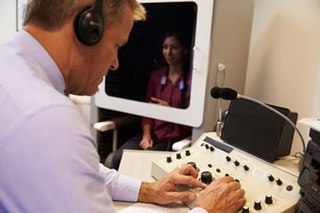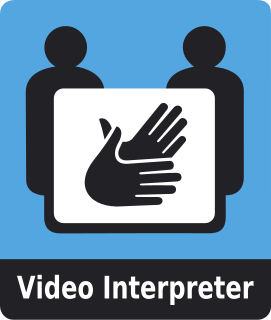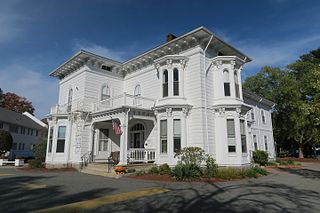Related Research Articles

Deaf culture is the set of social beliefs, behaviors, art, literary traditions, history, values, and shared institutions of communities that are influenced by deafness and which use sign languages as the main means of communication. When used as a cultural label especially within the culture, the word deaf is often written with a capital D and referred to as "big D Deaf" in speech and sign. When used as a label for the audiological condition, it is written with a lower case d. Carl G. Croneberg coined the term "Deaf Culture" and he was the first to discuss analogies between Deaf and hearing cultures in his appendices C/D of the 1965 Dictionary of American Sign Language.

Audiology is a branch of science that studies hearing, balance, and related disorders. Audiologists treat those with hearing loss and proactively prevent related damage. By employing various testing strategies, audiologists aim to determine whether someone has normal sensitivity to sounds. If hearing loss is identified, audiologists determine which portions of hearing are affected, to what degree, and where the lesion causing the hearing loss is found. If an audiologist determines that a hearing loss or vestibular abnormality is present, they will provide recommendations for interventions or rehabilitation.
Audism is discrimination against Deaf/deaf people. Tom L. Humphries coined the term in his doctoral dissertation in 1975, but it did not start to catch on until Harlan Lane used it in his writing. Humphries originally applied audism to individual attitudes and practices; whereas Lane broadened the term to include oppression of deaf people.
A communicative disorders assistant (CDA) performs hearing and speech-language screenings, prepares therapy materials, implements speech therapy, reports on therapy outcomes, performs routine maintenance on clinical equipment, and works with speech-language pathologists (SLPs) and audiologists to adjust therapy goals. While CDAs cannot perform assessments or set therapy goals, they are a vital part of the therapy team. CDAs are supervised by and work in conjunction with SLPs and audiologists.

A video relay service (VRS), also sometimes known as a video interpreting service (VIS), is a video telecommunication service that allows deaf, hard-of-hearing, and speech-impaired (D-HOH-SI) individuals to communicate over video telephones and similar technologies with hearing people in real-time, via a sign language interpreter.

The Learning Center for the Deaf (TLC) is a Framingham, Massachusetts-based non-profit organization and school serving deaf and hard-of-hearing children and adults.

Beverly School for the Deaf is a school, established in 1876, for students from birth to age twenty-two who are Deaf, Hard-of-Hearing and/or have cochlear implants by providing language that is visually accessible via American Sign Language, written English, speech, and AAC/Assistive Technology. The school also serves students who have language issues caused by conditions such as autism spectrum disorder, pervasive developmental disorders, and cerebral palsy.
The American Speech–Language–Hearing Association (ASHA) is a professional association for speech–language pathologists, audiologists, and speech, language, and hearing scientists in the United States and internationally. It has more than 197,856 members and affiliates.

Speech–language pathology is a field of expertise practiced by a clinician known as a speech–language pathologist (SLP) or a speech and language therapist, both of whom may be known by the shortened description, speech therapist. Speech–language pathology is considered a "related health profession" or "allied health profession", along with audiology, optometry, occupational therapy, rehabilitation psychology, physical therapy, behavior analysis and others.

Established in 1938, the Atlanta Speech School is a brain research-backed comprehensive language and literacy school providing educational as well as clinical programs. In addition, Atlanta Speech School's Rollins Center provides professional development for teachers and educators in partner schools and preschools. Rollins' work focuses on the eradication of illiteracy, a mission amplified by their online presence, Cox Campus. Cox Campus is a universally-accessible learning environment with coursework targeted for educations of children age 0-8.
Singapore Sign Language, or SgSL, is the native sign language used by the deaf and hard of hearing in Singapore, developed over six decades since the setting up of the first school for the Deaf in 1954. Since Singapore's independence in 1965, the Singapore deaf community has had to adapt to many linguistic changes. Today, the local deaf community recognises Singapore Sign Language (SgSL) as a reflection of Singapore's diverse linguistic culture. SgSL is influenced by Shanghainese Sign Language (SSL), American Sign Language (ASL), Signing Exact English (SEE-II) and locally developed signs. The total number of deaf clients registered with The Singapore Association For The Deaf (SADeaf), an organisation that advocates equal opportunity for the deaf, is 5,756, as of 2014. Among which, only about one-third stated their knowledge of Sign Language.
The Vermont Center for the Deaf and Hard of Hearing, a non-profit organization, was the primary educational and support services resource for Deaf and Hard of Hearing residents in Vermont and surrounding areas. Headquartered at Brattleboro's Austine school for the Deaf, the Vermont Center was launched by the Austine School in 1998 and operated until 2014. The Austine School was one of four independent schools and twelve outreach programs through which the Vermont Center assisted thousands of Vermonters who had hearing loss.
Aural rehabilitation is the process of identifying and diagnosing a hearing loss, providing different types of therapies to clients who are hard of hearing, and implementing different amplification devices to aid the client’s hearing abilities. Aural rehab includes specific procedures in which each therapy and amplification device has as its goal the habilitation or rehabilitation of persons to overcome the handicap (disability) caused by a hearing impairment or deafness.

Deaf education is the education of students with any degree of hearing loss or deafness. This may involve, but does not always, individually-planned, systematically-monitored teaching methods, adaptive materials, accessible settings, and other interventions designed to help students achieve a higher level of self-sufficiency and success in the school and community than they would achieve with a typical classroom education. A number of countries focus on training teachers to teach deaf students with a variety of approaches and have organizations to aid deaf students.
Speech and language impairment are basic categories that might be drawn in issues of communication involve hearing, speech, language, and fluency.
Speech-Language & Audiology Canada (SAC), formerly known as the Canadian Association of Speech-Language Pathologists and Audiologists (CASLPA), is a national organization supporting and representing speech-language pathologists, audiologists and communication health assistants. The association adopted its new name and logo on February 5, 2014.
Canadian Hearing Services was founded in 1940 to provide services for deaf and hard of hearing people in Ontario. Services include instruction in American and Quebec sign languages, interpreter services, deafblind intervenors, audiology and speech-language pathology. The CHS advocates for the hearing impaired in Canada through the support of 9-1-1 texting, visual fire alarms, and access to the justice system. The CHS handles emergency situations in hospitals, emergency rooms, after-hours clinics, shelters, and police services.
The Boston Guild for the Hard of Hearing (BGHH) was founded in 1916 as the Speech Reader's Guild by Mildred Kennedy, Anna L. Staples, and Clara M. Ziegler, three teachers at the Mueller-Walle School of Lip Reading in Boston. Until its closure in 2003, the BGHH was the largest nonprofit organization in New England dedicated to serving the needs of people with hearing impairment. Although the BGHH closed, the Speech Audiology Department at Northeastern University continues the BGHH's mission to provide services to the hearing impaired.
Nan Bernstein Ratner is a professor in the Department of Hearing and Speech Sciences at the University of Maryland, College Park. Ratner is a board-recognized specialist in child language disorders.
The Language Equality and Acquisition for Deaf Kids (LEAD-K) campaign is a grassroots organization. Its mission is to work towards kindergarten readiness for deaf and hard-of-hearing children by promoting access to both American Sign Language (ASL) and English. LEAD-K defines kindergarten readiness as perceptive and expressive proficiency in language by the age of five. Deaf and hard-of-hearing children are at high risk of being cut off from language, language deprivation, which can have far-reaching consequences in many areas of development. There are a variety of methods to expose Deaf and hard-of-hearing children to language, including hearing aids, cochlear implants, sign language, and speech and language interventions such as auditory/verbal therapy and Listening and Spoken Language therapy. The LEAD-K initiative was established in response to perceived high rates of delayed language acquisition or language deprivation displayed among that demographic, leading to low proficiency in English skills later in life, despite research showing that children who receive cochlear implants and appropriate therapy tend to learn language at the same level as their hearing peers. The general mission of the group is to promote the use of American Sign Language by Deaf and hard-of-hearing children as early as possible. It has been met with a wide variety of responses, including pushback from organizations and families that promote Listening and Spoken Language for deaf children.
References
- 1 2 3 4 5 6 7 Machen, Mary Gresham (1968). The Baltimore Hearing Society - A Survey of the Past – via The Internet Archive.
- ↑ Freedman, Allie (August 14, 2014). "New and Notable in Baltimore". Baltimore Jewish Times.
- ↑ Rotatori, Anthony F.; Obiakor, Festus E.; Bakken, Jeffrey B., eds. (2011). Advances in Special Education. 21. Emerald Group Publishing.
- ↑ "Interpreting & Communication Access Services". Governors Office of the Deaf and Hard of Hearing.
- ↑ Dorsett, Anne L (November 1927). "The President's Report". League News: Speech Reader's League of Baltimore 1. p. 2.
In June our League was made a member of the A.F.O.H.H. and two representatives were sent to the annual Federation Conference held at Chatauqua, New York.
- ↑ Ward, Anne D. (July 1936). "Committee on Membership". The Baltimore Council of Social Agencies. p. 16.
The Board of the Council of Social Agencies recommends to the Community Fund that admission of the League to membership in the Community Fund be deferred for the present...
- ↑ Ward, Anne D. (May 1936). "Committee on Membership". The Baltimore Council of Social Agencies. p. 16.
[I]t is the Council's opinion that from the point of view of the field of work in which the League operates as well as from the point of view of its present standards of performance the League is qualified for membership in the Community Fund...
- ↑ "Hearing Society Opens New Speech Clinic". The Evening Sun. Baltimore. August 11, 1960 – via The Internet Archive.
- 1 2 "Hearing and Speech Services: A study of services and activities in response to the communicative disorders". Health & Welfare Council of Baltimore Area, Inc. October 27, 1965 – via The Internet Archive.
- 1 2 "New Program to Offer Remote Access for ASL and Foreign Language Interp". PRWeb (Press release). November 16, 2012. Retrieved April 19, 2017.
- ↑ "State of Maryland 2006 Bond Bill Fact Sheet" (PDF). State of Maryland. 2006.
- 1 2 3 "2016 HASA Annual Report to the Community" (PDF). The Hearing and Speech Agency. 2016.
- ↑ "The Hearing and Speech Agency Hearing Aid Clinic in Baltimore, Maryland". HearingTracker.com. Archived from the original on April 20, 2017. Retrieved April 19, 2017.CS1 maint: unfit URL (link)
- ↑ Cohn, Meredith (January 26, 2017). "There are therapies when children don't outgrow stuttering". Baltimore Sun. Retrieved April 19, 2017.
- ↑ "Tips for hosting guests with sensory sensitivities". WMAR. December 12, 2016. Retrieved April 19, 2017.
- ↑ "Gateway School". The Maryland Association of Nonpublic Special Education Facilities. Retrieved April 19, 2017.